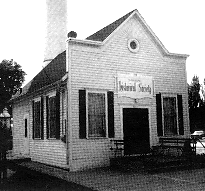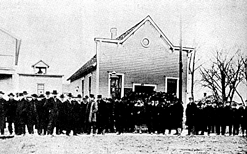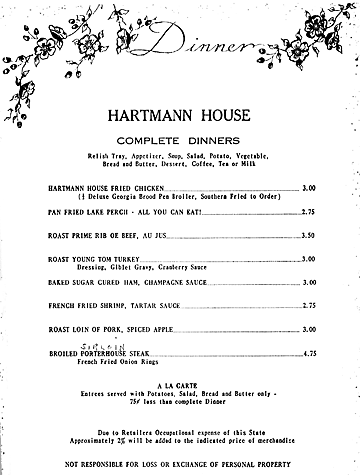History of the Village:
Wheeling Through The Years
The soft cover book Wheeling Through the Years
an oral history of Wheeling, an Illinois village contains
over 250 8x11 pages, and is available for purchase through the
Historical Society for $25.00 directly, or by mail with a $5.00
shipping and handling charge.
This book contains chapters on growing up in Old
Wheeling, school days, girl scouts, homesteading, Yankee farmers,
German farmers, Wheeling Train Station, Crane farms, Denoyer farm,
Milwaukee Avenue, Early planes and airports, prohibition, World War
II, Hispanics, organizations, churches, and much more. Illustrated
with photographs from the 1700's through the 1980's. Some
samples are included below.
If you are at all interested in Wheeling's past, we would like very much for you to join us in the preservation of our history and artifacts. If you would like to become an active member of the Wheeling Historical Society, please fill out the online application and mail it to us. and mail it to us.
| FIRE HOUSE on the north side of Dundee Rd. just west of Milwaukee Ave. was built with funds raised by the Volunteer Fire Department and the Chamber of Commerce at Wheeling Days and other events. A second floor was added later on and the building served the village hall and police station, as well as quarters for community services from time to time. |
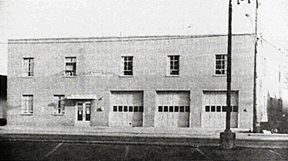 |
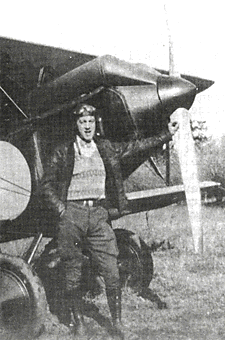 |
CHARLES D. BALLING was an early Wheeling flier, shown in his three-seat Lincoln Paige plane. He flew passengers out of a field at Deerfield Rd. and Milwaukee Ave., and worked for a time at Pal-Waukee
Airport.
|
| PAL-WAUKEE from the air in March, 1929. The four airplanes in a row face cars drawn up along Palatine Rd. It was customary to stop and watch the fliers on Sunday. A gas station occupies the corner of the field. Across from it, at far left, is the Strong School which was named for Wheeling's first settler who homesteaded the land. Beyond Palatine Rd. is Allison's Farm, with barn and silo and a corner building that served different purposes at different times. |
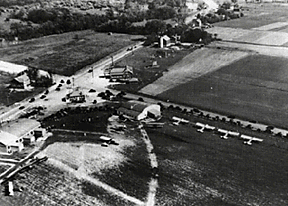 |
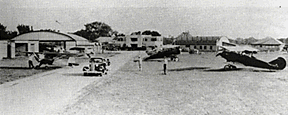 |
SINGLE-ENGINE PLANES like these were the most popular ones at Pal-Waukee in its early years. They provided basic air travel, with a feel of the air that made flying a sport. |
| GOODYEAR BLIMP was hangered at Pal-Waukee Airport during the Century of Progress Exposition in 1933-34. Crew members made their homes in Wheeling. |
 |
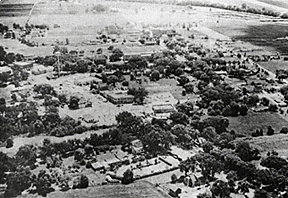 |
DOWNTOWN WHEELING as seen from the air in a photo by Rudy Horcher. In the foreground are Haagerstrom's ironwork studio and Don Roth's restaurant with its parking lot. Above them is the Wheeling State Bank on the corner of Milwaukee Ave. and Dundee Rd. and up to the left is the water tower with the old village hall at its feet. |
| RUNWAYS WERE PAVED and extended, hangars were built, and airport use expanded so much that planes were staked out in the field as the Fifties ushered in a new era at Pal-Waukee. |
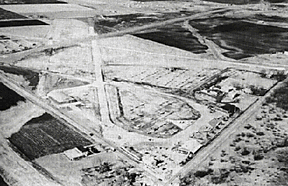 |
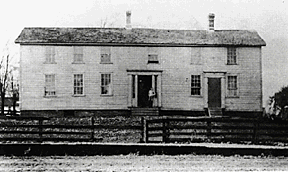 |
FILKINS TAVERN building survived through a long transition from bustling stage coach stop to common residence. This photograph was taken not long before it was torn down in 1918 to make way for commercial development where it stood.
|
| THE CHICAGO HOUSE was built by Martin Armbruster in 1873 and was taken over by Henry Harmann in 1901. It became known as Harmann's Chicago House and then as Hartmann House. |
 |
| RED MARY'S WHEELING INN was an infamous place set back from the road on the northeast corner of Dundee and Milwaukee, about where Cole-Taylor Bank/Main is now. For a period it featured big bands, gambling and expensive entertainment. |
 |
 |
BEHM'S RIVERSIDE restaurant was on the site now occupied by Hackney's, on S. Milwaukee Ave. It was among the famous eating places that attracted diners from all along the north shore and provided jobs for many of the Wheeling women.
|
| THE UNION HOTEL was built by Jacob Hunsinger in 1856, on the west side of Milwaukee Ave. A hall was added and was a center of social activity. Both burned down in 1925. |
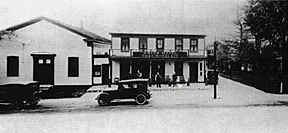 |
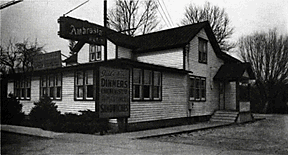 |
MOELLERS' RESTAURANT was on S. Milwaukee Ave. where Le Frances restaurant stands now. Frances and Fred are behind the bar (right) and you also can see slot and pinball machines. The "one-armed bandits" were an important part of the scene in Wheeling until widespread enforcement of gambling laws. |
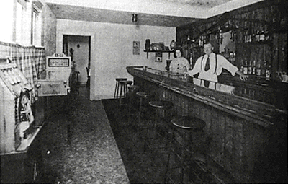 |
|
POLISH VILLAGE was a restaurant just south of Wheeling, between Milwaukee Ave. and the Des Plaines River, and was flooded when the river was high. It was built in 1937 by Otto Orlowski, Sr., who owned a Sunday morning Polish hour program on radio station WSBC.
|
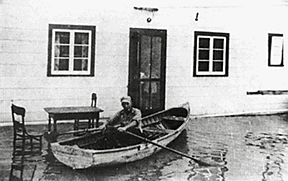 |
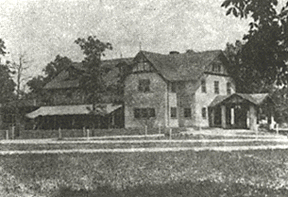 |
THE HOUSE THAT JACK BUILT was on the river, just south of the bridge where Milwaukee Ave. crosses it. It became Papa Bouche's Villa Venice, an expensive restaurant with big-name entertainment. |
HARTMANN HOUSE moved from the old, frame Chicago House to this cement block building at 393 S. Milwaukee Avenue in 1917. Henry Hartmann's son, Harold, ran it until 1955. A menu of that era is below. Taken over by Adam Schieck, it became "Adam's Hartmann House." Since then it has been the Spaghetti Factory and most recently the Crab House. |
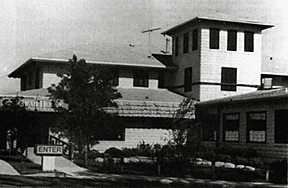 |
|
 |
AUTO STATION NO. 1 appeared on the sign at the Union Hotel as automobiles replaced the horse-drawn carriage. Wheeling's Restaurant Row always catered to travelers, whether on a long journey or out for a Sunday afternoon drive. |
UTPADEL BUILDING, made of the family's locally produced cement blocks, had stores at ground level with living quarters upstairs. Later it became a restaurant, known as Mary's Wheel Inn (right). It was on the east side of Milwaukee Ave., a few doors south of Dundee Rd. |
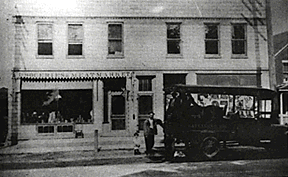 |
| |
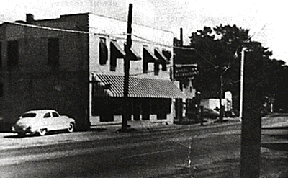 |
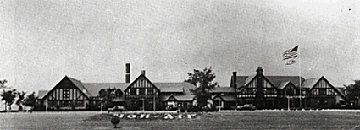
(Click for larger view) |
COLUMBIAN COUNTRY CLUB was built in 1917 by the Knights of Columbus. It became the Bon Air in prohibition days. Later it was named Chevy Chase Country Club and a referendum in 1977 financed its purchase by the Wheeling Park District. |
THE AMVETS took over the old Chicago House and adjacent property on the river. They refurbished it as their quarters and picnic area, selling it in 1973 when the site was bought to build Hein's Pub and Wheeling Auto Parts.
|
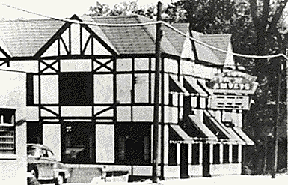 |
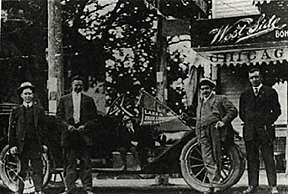 |
CHICAGOANS stopped at the restaurants on the way to and from the north. Here August Hey and his friends pose beside his car on the way home from a day at the Lake County Fair. |
|

